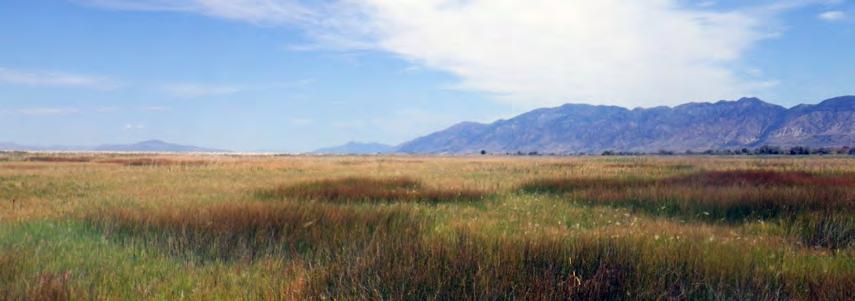
2 minute read
Chapter 3: Meadow Wetlands
Meadow Wetlands
Meadow wetlands, typically referred to as meadows, are defined by temporary or seasonal shallow flooding or saturated soils. Meadows comprise nearly 390 km² (97,225 ac) around Great Salt Lake (GSL) and are divided into wet and salt meadows based on differences in typical salinity ranges and dominant plant species.55 Across these ranges, meadow plant communities are characterized by shorter grasses and sedges that are well-adapted to fluctuating water levels. Most meadows are either located on low-angled slopes at slightly higher elevation than submergent and emergent wetlands, or they are on the outside edges of depressions and streams. Due to frequent proximity to agricultural land, many GSL meadows are grazed by cattle.
Plants
A number of plant species are important to wet and salt meadow, although specific species are representative of either wet or salt meadows because of salinity. While a wet meadow is an especially species-rich habitat because of low soil salinity, a salt meadow is unique because of its salinity tolerant plants. Common spikerush (Eleocharis palustris, p. 83) is one important wet meadow species. It is often the first plant to grow in disturbed areas and can quickly colonize bare areas following a drawdown. However, common spikerush is intolerant of elevated salinity and stunts at salinities above 6 ppt.55 Wet meadows often contain grasses and forbs. Slimstem
reedgrass (Calamagrostis stricta, p. 96) and timothy (Phleum pratense, p. 102) are two characteristic wet meadow grasses, although they are found
infrequently. An abundance of common forbs, such as nodding beggartick (Bidens cernua, p. 74), are also present in wet meadows. Saltgrass (Distichlis spicata, p. 97) is the most important habitat species in salt meadows because it provides nesting cover for a number of waterfowl species.66 As a drought-tolerant, salt-tolerant species that grows in dense mats and expands via rhizomes, saltgrass can grow in wetland soils with salinity greater than 30 ppt without any impacts to growth or seed production.6; 13 Periodic wetland burning can stimulate saltgrass growth because it creates bare ground that can be colonized by new growth from both seeds and rhizomes.46 Nebraska sedge (Carex nebrascensis, p. 81) and clustered field sedge (Carex praegracilis, p. 82) are common sedges in GSL salt meadows. Both species often grow in the same habitat—saturated to shallowly flooded meadows—and support the same bird species, but Nebraska sedge is taller, has larger seeds, and is more tolerant of alkaline conditions (pH of 7.5 of more).54 Seasonally fluctuating water levels are beneficial to sedges, and dry periods are especially important after inundation.54 As a stable wetland species, Nebraska sedge can be used to treat wastewater and is often a key species in determining the severity of cattle grazing pressure. If grazing is impairing a meadow, the rhizomatous structure of Nebraska sedge, which typically protects soil from erosion, will become weakened and more tolerant species will replace it. Like sedges, arctic rush (Juncus arcticus, p. 89) is a salt meadow plant that benefits from fluctuating water levels. Arctic rush can tolerate brackish and alkaline soil, seasonal drought, shade, and frequent disturbance.48 Arctic rushes’ broad range of tolerance, combined with its dense, rhizomatous growth, makes it a particularly valuable native salt meadow species because it can prevent the spread of invasive vegetation.





